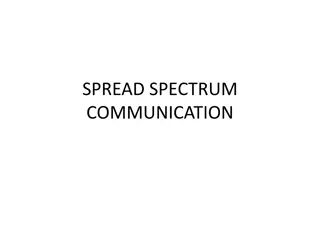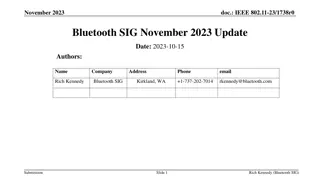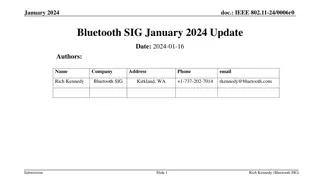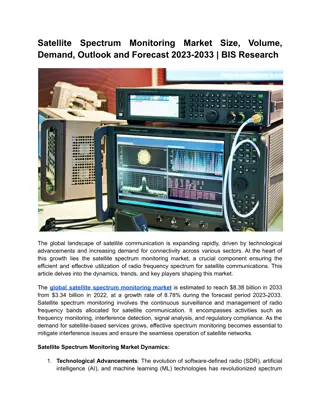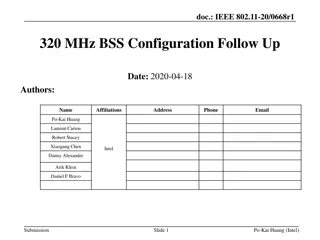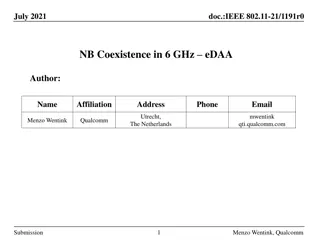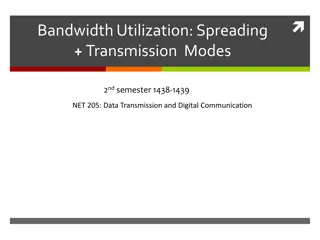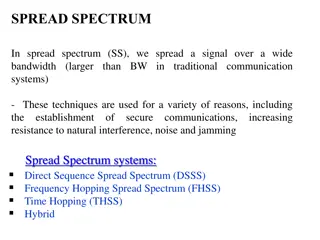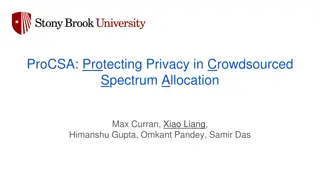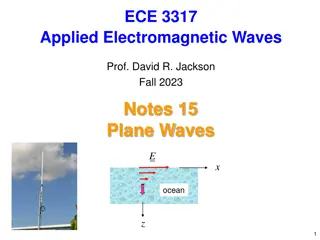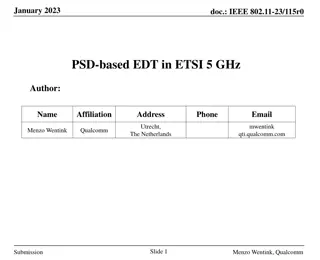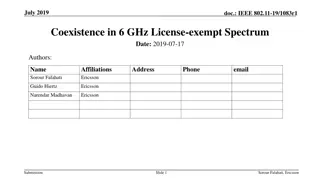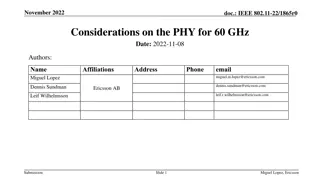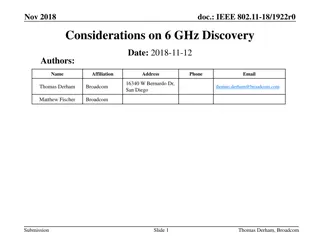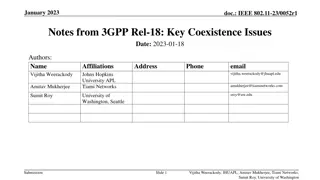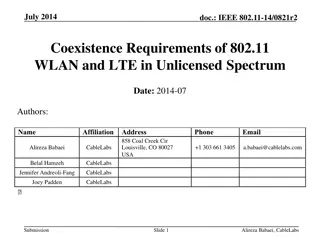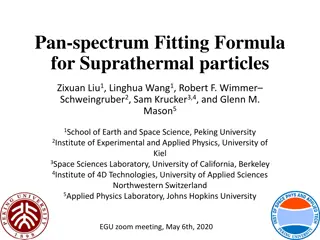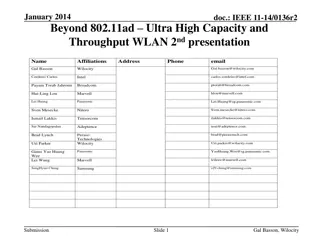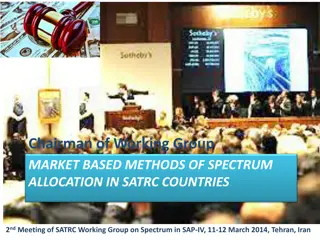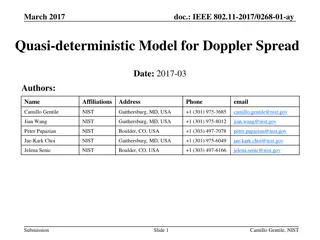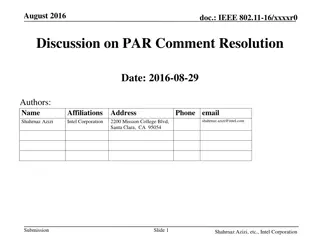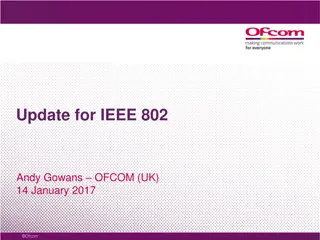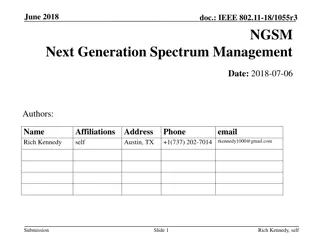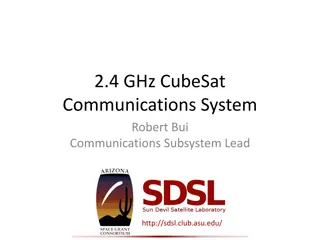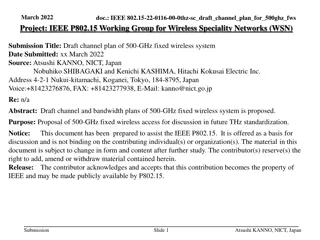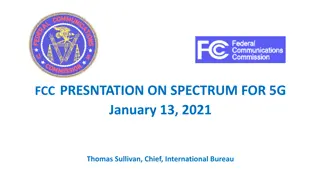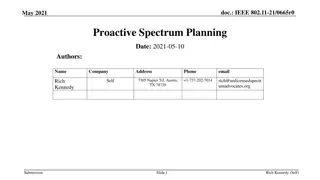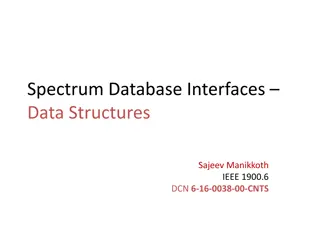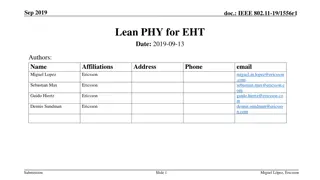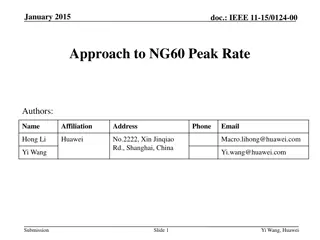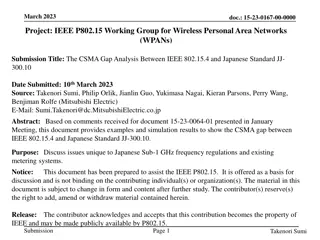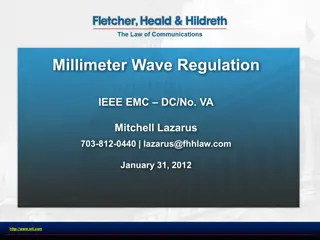High-Level Thoughts on Integrated mmWave Communication for WLAN Solutions
Market demands for WLAN solutions supporting high throughput and low latency applications have led to the development of Integrated mmWave (IMMW). This project focuses on integrating the mmwave band with sub-7GHz links to overcome range, mobility, and reliability challenges. IMMW aims to harmonize d
1 views • 7 slides
Bluetooth SIG September 2023 Update on Spectrum Sharing Plans
Bluetooth SIG provided an update on their actions and plans for sharing the 5 and 6 GHz bands with incumbents and unlicensed devices. They aim to collaborate with the Wi-Fi industry to enable equitable sharing for Bluetooth, particularly focusing on the 6 GHz band. The overall plan includes forming
4 views • 8 slides
Understanding Spread Spectrum Communication
Spread spectrum communication is a favored technology in military and commercial applications due to its resistance to jamming and interception. By spreading signals over a wide range of frequencies, it enhances security through encryption and authentication, making it challenging for attackers to d
4 views • 17 slides
Revising ETSI Standard for License-Exempt Operation in 6 GHz Band
Work has commenced on revising the ETSI standard EN 303.687 for license-exempt operation in the 6 GHz band to expedite completion. This revision project outlines the history, New Work Item approval, ETSI processes, and the upcoming steps. It traces back to 2017 when Switzerland and ECC administratio
0 views • 10 slides
Update on Bluetooth SIG's Spectrum Sharing Plans
This update discusses Bluetooth SIG's actions and plans for sharing the 5 and 6 GHz bands with incumbents and unlicensed devices. It highlights the goals, the overall plan, recent actions, and collaboration with the Wi-Fi industry to enable equitable sharing of these bands. The detailed plan involve
0 views • 9 slides
Update on Bluetooth SIG's Plans for Spectrum Sharing in January 2024
Bluetooth SIG presents an update on their actions and plans for sharing the 5 and 6 GHz bands with incumbents and unlicensed devices. Recognizing the need for future growth, they aim to collaborate with the Wi-Fi industry to develop optimal sharing mechanisms in the 6 GHz band. Their plan includes c
0 views • 11 slides
Satellite Spectrum Monitoring Market Outlook and Forecast 2023-2033
The global satellite spectrum monitoring market is estimated to reach $5.14 billion in 2031 from $2.55 billion in 2021, at a growth rate of 7.24% during the forecast period.\nRead Report Overview: \/\/bisresearch.com\/industry-report\/satellite-spectrum-monitoring-market.html
1 views • 3 slides
IEEE 802.11-20/0668r1: EHT BSS Configuration Proposal
The document discusses the configuration of a 320 MHz BSS in the context of 6 GHz regulations, focusing on EHT operation elements such as channel width indication, CCFS principles, and BSS advertisement settings. It proposes design principles for managing legacy and EHT STA operations, emphasizing s
0 views • 14 slides
Coexistence Challenges and Solutions in 6 GHz Networks
Various submissions address narrowband (NB) coexistence issues in the 6 GHz frequency band, focusing on Enhanced Detect and Avoid (eDAA) mechanisms to ensure harmonious coexistence between Wi-Fi and NB devices. The proposals discuss channel access rules, interference measurements, simulation results
1 views • 14 slides
Spectrum Sensing for Enhanced Channel Access in Wireless Networks
This document presents a proposal for Spectrum Sensing Based Deferral (SSBD) to improve channel access in wireless networks. SSBD incorporates spectrum sensing with transmission deferral in a time-bound manner to enhance performance, reliability, and latency control. The proposed solution safeguards
1 views • 11 slides
Understanding Spread Spectrum Techniques in Data Transmission
Explore the concepts of bandwidth utilization, spreading, and transmission modes in data transmission and digital communication. Learn about spread spectrum techniques such as frequency hopping and direct sequence spread spectrum, which enable efficient sharing of wireless communication channels. Di
1 views • 28 slides
Understanding Spread Spectrum Communication Systems
Spread spectrum techniques involve spreading a signal over a wide bandwidth for various reasons, such as secure communication, resistance to interference, noise, and jamming. This summary introduces Direct Sequence Spread Spectrum (DSSS), Frequency Hopping Spread Spectrum (FHSS), Time Hopping, and h
0 views • 25 slides
Enhancing Privacy in Crowdsourced Spectrum Allocation
This research focuses on protecting privacy in crowdsourced spectrum allocation, addressing the security challenges faced due to the presence of multiple entities and the sensitive information collected. By proposing potential ideas like Fully Homomorphic Encryption (FHE) and Secure Multi-Party Comp
0 views • 26 slides
Understanding Electromagnetic Waves: A Comprehensive Overview
Introduction to plane waves, the electromagnetic spectrum, TV and radio spectrum, and a comparison of wired and wireless systems. Discusses the properties and applications of various frequency ranges within the electromagnetic spectrum. Highlights the efficiency of wireless systems over wired system
0 views • 37 slides
PSD-based Energy Detect Threshold (EDT) in ETSI 5 GHz Standard
ETSI BRAN adopted a PSD-based EDT into the 5 GHz standard, specifying thresholds for energy detection levels. The new definition replaces the previous -72 dBm/20 MHz EDT, offering a compromise between power limits and channel configurations. Detailed examples and operational guidelines are provided
0 views • 6 slides
Coexistence in 6 GHz License-Exempt Spectrum - IEEE 802.11-19/1083r1
This document discusses the principles and key features of unlicensed spectrum in the 6 GHz frequency band, focusing on coexistence with incumbent services, spectrum efficiency, and regulatory discussions. It also delves into channel access design for 3GPP technologies in the 5 GHz band, highlightin
0 views • 12 slides
Considerations on PHY for 60 GHz in IEEE 802.11-22/1865r0 Document
The document discusses the possibility of standardizing multi-link (ML) with bands in the sub-7 GHz range combined with bands in the 45-72 GHz range, proposing reusing a sub-7 GHz PHY for mmWave bands. It explores the impact of phase noise on choosing the OFDM numerology for operation in the 45-72 G
1 views • 13 slides
Considerations on 6 GHz Discovery for IEEE 802.11-18/1922r0
IEEE 802.11-18/1922r0 document discusses the background and regulatory context for supporting 6 GHz operation in 802.11ax networks. It focuses on optimizing the discovery process for 6 GHz channels to enhance STA and network KPIs. The typical scanning/discovery procedure for non-AP STAs is outlined,
2 views • 14 slides
Key Coexistence Issues in 5-7 GHz Unlicensed Spectrum for NR Sidelink Evolution
3GPP RAN1 is extending NR sidelink operation to 5-7 GHz unlicensed spectrum, raising concerns about channel access and physical design. Discussions include Listen Before Talk protocols, UE-to-UE COT sharing, and coexistence with WiFi technologies. The study aims to specify support for sidelink on un
0 views • 14 slides
ICAO Handbook on Radio Frequency Spectrum Requirements for Civil Aviation Workshops
This handbook provides insights into spectrum requirements for civil aviation workshops conducted in Egypt and Thailand in October 2016. It covers spectrum strategy, frequency management, spectrum overview for aviation, and frequency assignment planning to support the application of SARPs in Annex 1
0 views • 10 slides
Coexistence Requirements of 802.11 WLAN and LTE in Unlicensed Spectrum
Presentation from July 2014 discussing the impact of LTE in unlicensed spectrum on 802.11 WLAN networks. Highlights proposals for TGax functional requirements document. Examines LTE-U and its challenges for coexistence with other technologies like Wi-Fi. Details LTE quiet periods and lab test condit
0 views • 12 slides
Understanding Magnetic Shielding Considerations for 3.9 GHz Cavities
This document discusses Q and magnetic shielding considerations for 3.9 GHz cavities used in the LCLS-II project, highlighting the unique behavior observed in nitrogen-treated cavities. The study delves into the improved Q values and field dependence of quality factors, challenging traditional niobi
0 views • 10 slides
802.11aj 45 GHz Channel Access and BSS Operation Framework Proposal
This document outlines a proposal for channel operation and BSS operation in the 45 GHz frequency bands for 802.11aj in China. It includes details on channelization, spectrum allocation, maximum transmit power, and BSS configuration rules. The aim is to meet the functional requirements specified whi
0 views • 32 slides
Unified Pan-Spectrum Fitting Formula for Suprathermal Particles
Unifying spectrum formulas for suprathermal particles, the proposed pan-spectrum formula provides a versatile fitting method encompassing classic double-power-law, band function, and kappa distribution. Motivated by the need for more accurate spectrum information, the formula introduces five paramet
0 views • 14 slides
Beyond 802.11ad: Ultra High Capacity and Throughput WLAN
The document from January 2014 discusses the exploration of modifications to IEEE 802.11ad-2012 PHY and MAC layers to enable modes of operation in the 60 GHz band capable of achieving a maximum throughput of at least 30 Gbps while maintaining the band's excellent capacity attributes. Topics include
0 views • 21 slides
Market-Based Spectrum Allocation Strategies in SATRC Countries
Explore the implementation of market-based methods for spectrum allocation in SATRC countries. Learn about the requirements, benefits, and challenges associated with adopting market-based mechanisms, especially in the context of increasing demand for spectrum and technological advancements. Discover
0 views • 41 slides
Parameterized Model for Doppler Spread in mmWave Systems
This document presents a parameterized model for Doppler spread in mmWave systems based on measurements with an 83 GHz channel sounder. The model is linked to the Quasi-deterministic (QD) propagation channel model adopted by the work group. It discusses Doppler frequency shift, channel sounder confi
0 views • 10 slides
IEEE 802.11-16/xxxxr0 August 2016 Discussion Summary
The document discusses comments and proposed resolutions regarding user data, different bands, operation, and latency in IEEE 802.11-16/xxxxr0. Various categories like wake-up packets, band definitions for 2.4 GHz and 5 GHz, radio transitions, and ongoing latency discussions are tackled in this Augu
0 views • 8 slides
Update for IEEE 802 by Andy Gowans OFCOM (UK) January 2017
Update on various issues related to IEEE 802 including release of 5.8 GHz in the UK, WRC-19 agenda items, spectrum requirements, consultation responses, and license-exempt spectrum in the UK. Discusses drivers for future demand, DFS, and potential global Wi-Fi band release. Details on bands, user re
0 views • 14 slides
Next Generation Spectrum Management Initiative Overview
Rich Kennedy presented on the need to change spectrum management practices within IEEE 802, addressing the results of straw polls conducted and proposing further investigation into Multi-band White Space feasibility. The presentation also highlighted the interest in advocating for an AI-managed spec
0 views • 14 slides
2.4 GHz CubeSat Communications System Overview
The 2.4 GHz CubeSat Communications System, led by Robert Bui, aims to establish a reliable data link between the SDS-1 Cube Satellite and the ASU ground station. Operating on the 13 cm amateur ham radio band at frequencies of 2400-2450 MHz, the system utilizes a Transceiver (MHX-2420) with a link ra
0 views • 10 slides
Draft Channel Plan of 500-GHz Fixed Wireless System for Ultra-High-Definition Surveillance
Proposed is a draft channel plan for a 500-GHz fixed wireless system suitable for ultra-high-definition surveillance applications in smart industries and public transportation. This system aims to enable high-capacity data transmission with low spectrum interference in short-distance links, offering
0 views • 10 slides
Cognitive Radio Network and Game Theory Exploration at University of Houston
Explore the application of cooperative game theory in cognitive radio networks, focusing on spectrum sensing, dynamic spectrum access, and coalitional games. Detailed overview of research conducted at the Department of Electrical and Computer Engineering, University of Houston. Learn about cognitive
0 views • 42 slides
The Future of 5G: FCC's Spectrum Plans and Innovations
The FCC's presentation highlighted the importance of spectrum for 5G development, emphasizing the key components of their 5G FAST Plan. The plan focuses on pushing more spectrum into the market, updating infrastructure policy, and modernizing regulations to drive innovation and investment in the U.S
0 views • 12 slides
IEEE 802 Spectrum Planning: Proactive Approach for Improved Spectrum Management
Exploring the need for proactive spectrum planning in IEEE 802 to better manage the complex process of meeting spectrum needs efficiently and effectively. Delving into the challenges of spectrum allocation, sharing, and optimization to ensure that standards have the RF spectrum necessary for their r
0 views • 9 slides
Understanding Spectrum Databases and PAWS Parameters
Explore the world of Spectrum Databases and PAWS parameters, which provide essential information about available spectrum, permissible power levels, regulatory domains, geolocation data, and more. Learn about typical deployments, data types, and spectrum scheduling to enhance your understanding of s
0 views • 16 slides
Relevance of Lean PHY for EHT in 6 GHz
Discussing the importance of a Lean PHY for EHT in 6 GHz to improve spectrum efficiency and reduce overhead. Introducing the Low Throughput PHY as a potential solution, highlighting its benefits compared to existing options like 802.11a. Measurement results show the impact and potential for enhancin
0 views • 14 slides
Next-Generation 60 GHz Peak Data Rate Technologies
This presentation delves into the exploration of potential technologies to meet the peak data rate requirements of NG-60, focusing on enhancements to IEEE 802.11 physical and medium access control layers. Various channel bonding scenarios and achievable peak data rates are discussed, aiming to reach
0 views • 9 slides
CSMA Gap Analysis Between IEEE 802.15.4 and Japanese Standard JJ-300.10
This document analyzes the differences in CSMA protocol and performance between IEEE 802.15.4 and Japanese Standard JJ-300.10, focusing on unique issues related to Japanese Sub-1 GHz frequency regulations and metering systems. With increasing data traffic and channel access demands, insights are pro
0 views • 19 slides
Understanding Millimeter Wave Regulation and FCC Restricted Bands
Overview of millimeter wave regulation by IEEE and FCC, including restricted bands, radar rules, advantages and disadvantages of millimeter wave signals, and FCC rules on restricted bands above 38.6 GHz. Details on communication bands, power regulations, and proposals for unlicensed usage in the 57-
0 views • 19 slides


